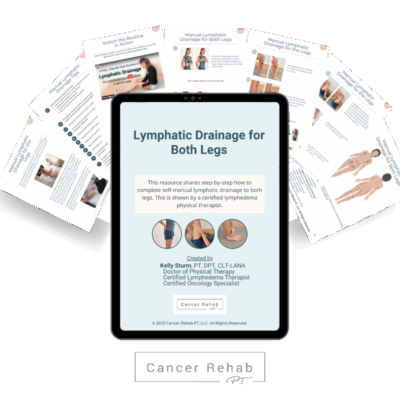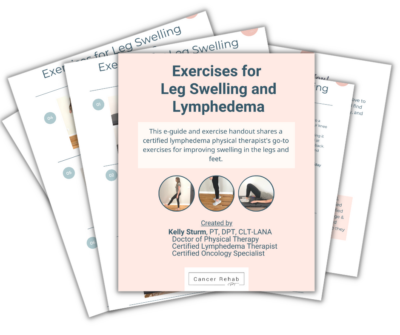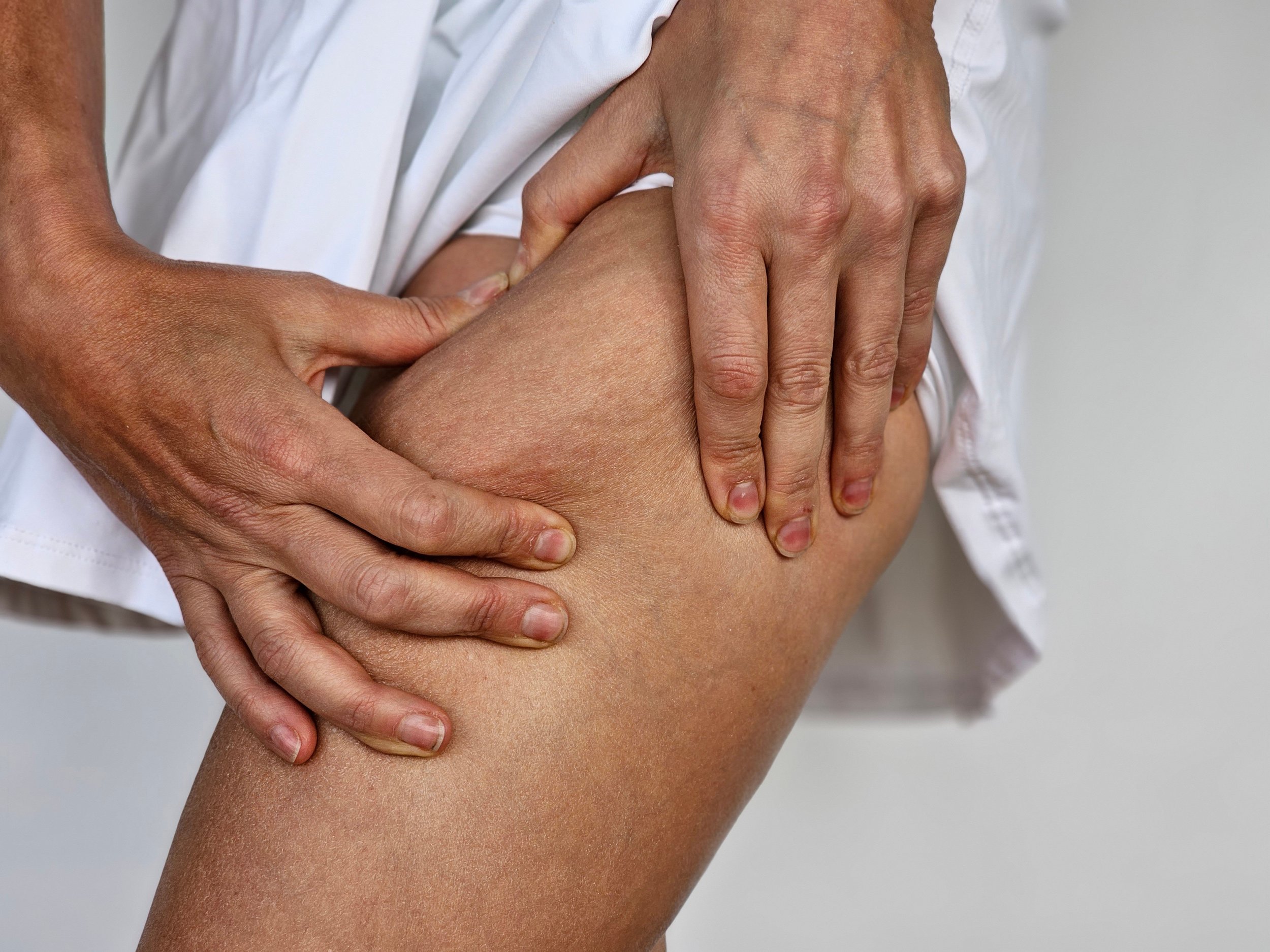Have you noticed that your left leg is swelling while your right leg remains normal? This can be concerning and uncomfortable, so you’re probably asking yourself, “Why is only my left leg swelling?”
There are several potential causes for left leg swelling, and more importantly, there are solutions that can help you manage and potentially get rid of the swelling.
👋 My name is Kelly Sturm, and I’m a Doctor of Physical Therapy, a Certified Lymphedema Therapist, and a Board-Certified Oncology Clinical Specialist.
In this article, I’ll explain the various reasons why your left leg might be swelling, with a particular focus on lymphedema – one of the most common causes of persistent leg swelling.
I’ll also discuss treatment options, including how physical exercise can help manage swelling in one leg, especially in cases of lymphedema.
Swelling in One Leg: Why It Happens
Before we dive into the specific causes of left leg swelling, it’s important to understand what leg swelling, or leg edema, actually is.
Edema occurs when excess fluid builds up in your body’s tissues. This can happen for many reasons, ranging from minor, temporary issues to more serious health conditions.
When swelling occurs in only one leg, it’s often a sign that something is affecting the circulation or fluid balance in that specific limb. This could be due to issues with blood clots, the lymphatic system, or other localized problems.

Common Causes of Left Leg Swelling
Let’s take a closer look at the common causes of left leg swelling, starting with lymphedema – one of the most frequent culprits.
Lymphedema
Lymphedema is a condition that develops when your lymphatic system doesn’t drain excess fluid from your body properly. This leads to a buildup of lymph fluid, causing swelling in the affected area.
Researchers estimate1 that lymphedema affects as many as 140 million to 250 million people worldwide. It’s a very common condition, but many people don’t have access to proper diagnosis and support.
There are two types of lymphedema:
- Primary lymphedema: a rare, inherited condition where the lymphatic system doesn’t develop properly
- Secondary lymphedema: the most common type of lymphedema that develops after surgery, radiation therapy, infection, or injury that damages the lymphatic system
Lymphedema often affects one leg more than the other, which could explain why you’re experiencing swelling in your left leg specifically (also known as unilateral leg swelling).
Symptoms of lymphedema include:
- Swelling in part or all of the leg
- A feeling of heaviness or tightness in the affected limb
- Restricted range of motion
- Aching or discomfort
- Hardening and thickening of the skin (in advanced stages)
If you suspect you might have lymphedema, seek medical advice as soon as possible. Early diagnosis and treatment can help manage symptoms and prevent severe swelling.
Lymphedema is a chronic condition, but with proper management, many people with lymphedema lead full, active lives.
Deep Vein Thrombosis (DVT)
Deep Vein Thrombosis is a condition when a blood clot forms in one of the deep veins of your body, often in the legs. This can cause swelling, pain, and warmth in the affected leg.
DVT is a serious condition that requires immediate medical attention, as the blood clot can potentially break loose and travel to the lungs, causing a life-threatening pulmonary embolism.
Risk factors for DVT include:
- Not moving for long periods (such as during long flights or bed rest)
- Recent surgery or injury
- Certain medical conditions (like heart disease or cancer)
- Hormonal changes (pregnancy, birth control pills)
- Obesity
- Smoking
If you experience sudden swelling in one leg, especially if accompanied by pain, redness, or warmth, seek medical attention right away.
Chronic Venous Insufficiency
Chronic venous insufficiency develops when the valves in your leg veins don’t work properly. This makes it difficult for blood to return to your heart. As a result, blood flow can pool in your legs, leading to swelling.
Symptoms of venous insufficiency include:
- Swelling in the lower leg and ankle
- Aching or tiredness in the legs
- Varicose veins
- Skin changes or ulcers on the legs
Risk factors include age, obesity, pregnancy, and a history of blood clots in the legs.
Injury or Trauma
An injury to your left leg, such as a sprain, fracture, or even an insect bite, can cause localized swelling or fluid buildup. This type of swelling is usually temporary and improves as the injury heals.
Infection
Cellulitis, a bacterial skin infection, can cause swelling, redness, and warmth in the affected area. It most commonly occurs in the lower legs and can affect one leg at a time.
Kidney or Liver Problems
While less common, issues with your kidneys or liver can sometimes lead to leg swelling. These conditions typically cause swelling in both legs, but in some cases, one leg may be more affected than the other.
Medication Side Effects
Certain medications, especially some blood pressure medications, steroids, and diabetes medications, can cause leg swelling and fluid retention as a side effect.
The Importance of Proper Diagnosis
These are some of the common reasons why only your left leg is swelling but don’t try to self-diagnose yourself.
If you’re experiencing persistent or unexplained swelling in your left leg, it’s important to consult with a healthcare professional.
Treatment Options for Leg Swelling
The treatment for your leg swelling will depend on its underlying cause. That said, there are a few general approaches that can help manage swelling, particularly in cases of leg lymphedema.
Physical Exercise and Leg Swelling
One of the best ways to manage leg swelling, especially in cases of lymphedema, is with physical exercise. Regular movement helps stimulate lymph flow and improve circulation, which can reduce swelling and discomfort.
All forms of gentle, low-impact exercise are beneficial for lymphedema, including:
- Walking: A simple walk can help pump fluids out of your legs. Start with short distances and gradually increase as you feel comfortable.
- Swimming: Swimming is a fantastic low-impact exercise, and the pressure of the water can help reduce swelling.
- Yoga: Certain yoga poses, especially those that elevate your legs, can be beneficial for reducing swelling.
- Physical Therapy Lymphedema Exercises: I share many lymphedema exercises on my YouTube Channel, and for in-depth support, check out Lower Body Lymphedema Rehab.
Pick a form of exercise that you enjoy and can consistently stick with. Regular movement is the best way to combat fluid accumulation and swollen legs, so make sure to incorporate some form of movement into your everyday routine (after getting a green light from your doctor!).
Other Treatment Options for Lymphedema
Exercise is one of the most important components of managing leg lymphedema, but there are several other treatment options available as well:
- Compression Therapy: Wearing compression stockings or bandages can help prevent fluid from accumulating in your leg. These garments apply pressure to your leg, encouraging fluid to flow out of your affected limb.
- Manual Lymphatic Drainage (MLD): This special massage technique stimulates lymphatic fluid drainage.
- Complete Decongestive Therapy (CDT): This is a comprehensive treatment approach that combines MLD, compression therapy, exercise, and skincare.
- Proper Skin Care: Keeping your skin clean and moisturized is crucial to prevent infections, which can worsen lymphedema.
- Weight Management: Maintaining a healthy weight can help reduce the strain on your lymphatic system.
If your left leg swelling is still minor, it may even be possible to prevent lymphedema from developing or reverse it.
Treatment for Other Causes of Leg Swelling
For other causes of leg swelling, treatment will vary:
- Deep Vein Thrombosis: Treatment typically involves blood-thinning medications to prevent the clot from growing and to reduce the risk of new clots forming.
- Venous Insufficiency: Treatment may include compression stockings, elevation, and in some cases, procedures to treat varicose veins.
- Infections: Bacterial infections like cellulitis are usually treated with antibiotics.
- Injuries: Treatment depends on the specific injury but may include rest, ice, compression, and elevation.
- Medication-induced swelling: Your doctor may adjust your medication or dosage if a medication is causing problematic swelling.
Make sure to get in touch with your doctor to get a proper diagnosis for your left leg swelling.

Don’t Accept Leg Swelling as Your New Normal
Dealing with leg swelling can be frustrating, but it’s important to remember that you don’t have to accept discomfort as your new normal – especially in the case of lymphedema.
You can get extensive support in Lower Body Lymphedema Rehab, and I also have downloadable digital guides for left leg swelling:
- Left Leg Manual Lymphatic Drainage Guide
- Full-Body Dry Brushing for a Healthy Lymphatic System
- Exercises for Leg Swelling and Lymphedema
- Leg Circulation Exercises
- Lymphatic Drainage Diagram for Left Leg and Pelvic Lymphedema
With proper diagnosis and treatment, many people successfully manage their leg swelling and lead full, active lives.
When to Seek Medical Attention for Leg Swelling
If you’re dealing with unexplained left leg swelling, you should get in touch with your doctor to get a proper diagnosis first. Then, with a proper diagnosis and treatment plan, many causes of leg swelling can be managed at home.
There are also times when you should seek immediate medical attention:
- Sudden, severe swelling in one leg, especially if accompanied by pain, warmth, or redness (which could indicate DVT)
- Swelling accompanied by chest pain or difficulty breathing (which could indicate a pulmonary embolism)
- Signs of infection, such as fever, redness, or warmth in the affected area
- Swelling that doesn’t improve with home care measures or as directed by your healthcare provider
In these cases, make sure to see a doctor as soon as possible.
FAQs
What Does It Mean When Only the Left Leg Swells?
When only your left leg swells, it usually means something is affecting the blood or lymph flow in that specific leg. There can be many reasons for that. One of the most common ones is lymphedema, a condition where your lymphatic system doesn’t drain fluid properly. Or it could be a blood clot, known as deep vein thrombosis. Sometimes it’s caused by an injury or infection in that leg. In rarer cases, it might be related to a vein problem or even an issue with your liver or kidneys.
Remember that one-sided leg swelling isn’t normal, and it’s worth getting checked out by a doctor to find out what’s causing it and how to treat it.
Does Left Leg Swelling Indicate Heart Problems?
Left leg swelling alone usually isn’t a direct sign of heart problems. Heart issues typically cause swelling in both legs. But if you have swelling in your left leg along with other symptoms like shortness of breath, chest pain, or a rapid heartbeat, it could potentially be related to a heart condition. If you’re worried about your heart or your leg swelling, it’s always best to consult with a healthcare provider for a proper evaluation.
How Do I Reduce Swelling in My Left Leg?
It depends on what’s causing your leg swelling. If lymphedema is the cause, then regular low-impact exercise along with other treatment approaches such as compression therapy and Manual Lymphatic Drainage (MLD) can be very effective. It’s important to first get a proper diagnosis.
Get More Support in Lower Body Lymphedema Rehab
If your left leg swelling is caused by lymphedema, you can get extensive support in Lower Body Lymphedema Rehab.
You’ll learn exercises and self-care practices that you can integrate into your daily routine to control swelling and improve your quality of life. Learn more!
Article Sources
- NIH National Library of Medicine ↩︎











